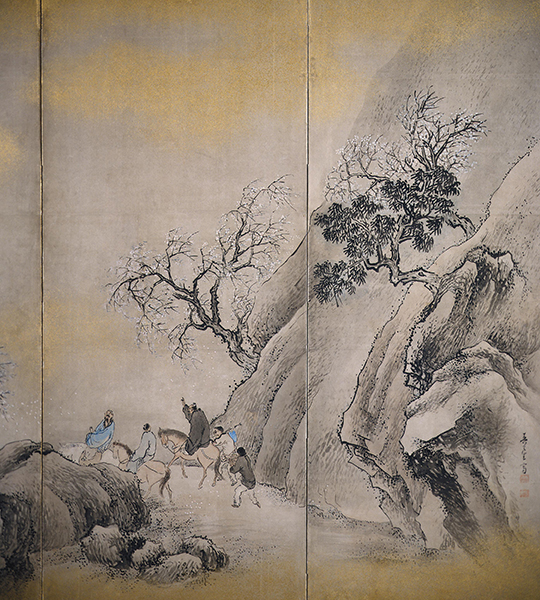World Watercolor Month: Yosa Buson
If any artists could be called the “masters” of watercolor, it would be the artists of Asia—particularly far eastern Asia (Japan, China, Korea)—who, for centuries, used ink and watercolor exclusively as finished works of art. These artists ground their own inks and colors from available natural minerals and were not heavy handed in their use of the medium. The word “subtle” to describe their use of color would be an understatement.
 |
| Yosa Buson (1716–1784, Japan), Travelers on Horseback on a Mountain in Spring, detail. Ink, watercolor, and gold leaf on paper, mounted as six-fold screen, section: 67 1/8" x 52 15/16" (170.5 x 134.5 cm). © 2020 Worcester Art Museum. (WAM-220) |
The Edo Period (1615–1868) is renowned in the West primarily for its rich tradition of multiple-block woodcut printing. However, a variety of painting styles also flourished. Chief among them were the Chinese-influenced (mostly Song period, 960–1279) monochromatic ink style and the traditional Japanese love of color and pattern seen in the yamato-e style that characterized much of the Kanō School, the dominant artist group that served the military nobility. By the early 1800s, both of these trends in Japanese painting began showing influences of newer Chinese painting (Ming and Qing dynasties, 1368–1644 and 1644–1912) and of Western art. These influences seeped through the only port open to Dutch, Chinese, and Portuguese traders: Nagasaki.
The late-Edo-Period interest in Chinese monochromatic painting, based on the Confucian ideal of reverence for nature and its principles, appealed to Japanese art patrons. Although there were no "scholar/amateur" painters in Japan as in China, the newly revived Confucian ideals appealed to the Japanese respect for ethical and intellectual achievement.
Japanese artists were able to study not only prints of Chinese art but printed Chinese manuals with lessons about painting in the traditional style. The style that emerged was called Nanga, or southern style, based on its ultimate roots in Southern Song (1127–1279) painting.
Yosa Buson (or Yosa no Buson) was born in Kema, Settsu Province (now a ward of Osaka). The family name was Taniguchi. He is perhaps more renowned for his poetry, which shaped the form of contemporary haiku. A member of a wealthy family, he left his privilege behind to study poetry and painting simultaneously. Yosa settled in Kyoto in 1751. Kyoto was the traditional seat of the emperor and a center for traditional art based on the Chinese monochromatic tradition.
Yosa was thoroughly acquainted with both Chinese and Japanese classics of poetry and painting. As an artist of the Nanga style, he would have seen woodcut reproductions of Chinese works. Those of the Song and Ming dynasty scholar/amateur painters influenced him the most. The asymmetrical composition, heavy emphasis on surface patterns, and ample suggestion of forms were great influences on Western artists starting in the late 1800s. The screen Travelers on Horseback on a Mountain in Spring does not follow the style of any particular Chinese artist.
Correlations to Davis programs: A Community Connection 2E: 4.5; A Global Pursuit 2E: 7.5; Experience Painting: Chapter 4; Discovering Art History 4E: 4.4


Comments